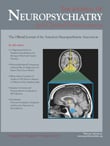Alice in Wonderland Syndrome in Major Depressive Disorder
To the Editor: Alice in Wonderland syndrome, described by Todd 1 in 1955, encompasses a variety of self-experienced body image disturbances which may co-occur with depersonalization, derealization, metamorphopsia, and distortion of time perception. 2 Although this syndrome has been mainly observed in neurological conditions such as migraine or epilepsy, there have been several descriptions of patients suffering from substance-related disorders and schizophrenia.
Case Report
A 74-year-old retired French executive was admitted to our University Hospital for major depressive disorder with psychotic features triggered by prostate surgery 3 months previously. His medical history had been unremarkable except for possible major depressive disorder 20 years previously which had not been treated. No family history of migraine or epilepsy was found during a psychiatric interview. The patient was described by his wife as usually sociable, jolly, scrupulous and a perfectionist. On admission, the patient presented with a depressed mood, loss of pleasure and interest, disordered sleeping, severe fatigue, loss of appetite, psychomotor retardation, and persecutory (being broken into and burgled) as well as somatic (his stools being contaminated) delusions. At that time, his Hamilton Depression Rating Scale (HAM-D) score was 32/52. Ten days after admission, the patient exhibited new delusional symptoms: he believed his hands and feet were shorter than usual and was convinced that his clothes had shrunk. Organic causes (intracranial tumor and infection, thyroid disease, and nutritional deficiency) were ruled out by physiological, laboratory, neurological, and ophthalmological investigations. First-line treatment combined venlafaxine (225 mg/day) and olanzapine (7.5 mg/day) for 1 month. The patient continued to be delusional and severely depressed (HAM-D=27/52). He only achieved remission after five bilateral ECT sessions over a period of 2 weeks, with a seizure duration range of 10–22 seconds. He was discharged on day 45 of hospitalization with complete remission (no delusional symptoms and HAM-D=7/52).
Discussion
Based on a previous case report, major depressive disorder has been suggested to be a causal factor for Alice in Wonderland syndrome, 3 and the course of our patient’s psychiatric symptoms supports this hypothesis. Furthermore, in line with this previous report, Alice in Wonderland syndrome symptoms associated with major depressive disorder seem to last longer than when they are associated with nonpsychiatric disorders. However, in contrast to previous clinical observations, our patient did not exhibit any disturbances in his perception of time. 3
Cotard’s syndrome, described by Jules Cotard in 1882, comprises any one of a series of delusions ranging from the belief that one has lost organs to the conviction that one is dead. 4 Since Cotard’s syndrome is also usually associated with severe depression and improves rapidly with ECT, 4 it is possible that the somatic delusions experienced by our patient were a variant of this syndrome.
According to our observations, the psychotic features of major depressive disorder might present in the form of Alice in Wonderland syndrome although the relationship between this syndrome and Cotard’s syndrome remains to be determined.
1. Todd J: The syndrome of Alice in Wonderland. Can Med Assoc J 1955; 73:701–704Google Scholar
2. Lambert MV, Sierra M, Phillips ML, et al: The spectrum of organic depersonalization: a review plus four new cases. J Neuropsychiatry Clin Neurosci 2002; 14:141–154Google Scholar
3. Mizuno M, Kashima H, Chiba H, et al: “Alice in Wonderland” syndrome as a precursor of depressive disorder. Psychopathology 1998; 31:85–89Google Scholar
4. Baeza I, Salva J, Bernardo M: Cotard’s syndrome in a young male bipolar patient. J Neuropsychiatry Clin Neurosci 2000; 12:119–120Google Scholar



